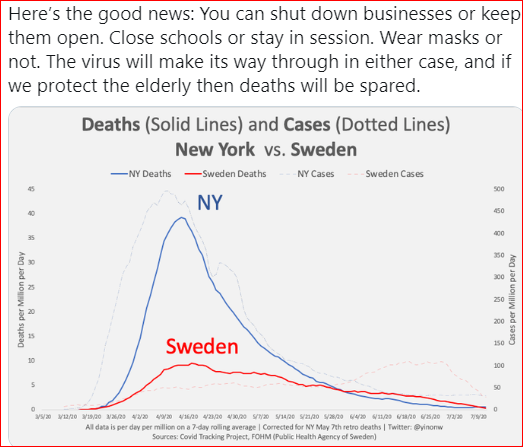Coronavirus deaths have slowed to a crawl in Sweden. With the exception of a single death on July 13, no deaths in this nation of 10 million have been reported since July 10.
...
Last week, The New York Times labeled Sweden’s approach to the pandemic a “cautionary tale” for the rest of the world, claiming it “yielded a surge of deaths without sparing its economy from damage.”

The reason Sweden is a “cautionary tale” and Belgium is not is because Belgium followed the script. Early in the pandemic, Belgian officials closed all non-essential business and enforced strict social distancing rules.
All non-emergency workers were told to stay home. Shopping was limited to a single family member. Individuals could leave for medical reasons or to walk a pet or get a brief bit of exercise—so long as social distancing was maintained.
These lockdown protocols, the BBC reported, were strictly enforced by Belgian police using “drones in parks and fines for anyone breaking social distancing rules.”
A More Suitable ‘Cautionary Tale’
Sweden clearly endured the pandemic better than Belgium, which had nearly twice as many COVID-19 deaths despite its economic lockdown.
Yet the Times chose Sweden as its “cautionary tale” because Sweden chose not to institute an economic lockdown. Sweden took such an approach for two reasons. First, as Tegnell has publicly stated, there is little to no scientific evidence that lockdowns work. Second, as evidence today shows, lockdowns come with widespread unintended consequences: mass unemployment, recession, social unrest, psychological deterioration, suicides, and drug overdoses.
Even if Sweden has seen its death toll rise more sharply than Scandinavian neighbors such as Finland and Norway, it’s strange that the Times would go thousands of miles across an ocean and continent to find a “cautionary tale.” A far better cautionary tale can be found right under the Grey Lady’s nose.
A simple comparison between New York and Sweden shows the Empire State has suffered far worse from COVID-19 than the Swedes. Yinon Weiss, an entrepreneur and founder of Rally Point, recently compared Sweden and New York using data from the COVID Tracking Project.

...
If flattening the curve was the primary goal of policymakers, Sweden was largely a success. New York, on the other hand, was not, despite widespread closures and strict enforcement of social distancing policies.
...
By embracing a much more market-based approach to the pandemic in lieu of a centrally planned one, Sweden is undermining the narrative that millions and millions of people would have died without lockdowns, as modelers predicted.
Without Sweden and a few similar outliers, it would be far easier for central planners to say, Sure, lockdowns were harsh and destructive. But we had no choice.
As Ludwig Von Mises noted long ago, modern social conflict is largely a struggle over who gets to design the world, individuals or authorities. Mises saw few things more dangerous than central planners seeking to supplant the plans of individuals with plans of their own, which they see as a preeminent good.
It was partly for this reason Mises saw market economies as superior to command economies.
“Whatever people do in the market economy, is the execution of their own plans. In this sense every human action means planning,” Mises wrote in Socialism: An Economic and Sociological Analysis.
“What those calling themselves planners advocate is not the substitution of planned action for letting things go. It is the substitution of the planner’s own plan for the plans of his fellow-men. The planner is a potential dictator who wants to deprive all other people of the power to plan and act according to their own plans. He aims at one thing only: the exclusive absolute pre-eminence of his own plan.”







